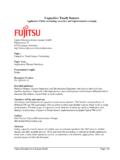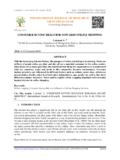Transcription of Touch in Therapy and the Standard of Care in Psychotherapy ...
1 Touch In Therapy And The Standard of care In Psychotherapy And Counseling: Bringing Clarity to Illusive Relationships Ofer Zur, Source: O. Zur (2007). Touch In Therapy and The Standard of care in Psychotherapy and Counseling: Bringing Clarity to Illusive Relationships. United States Association of Body Psychotherapists Journal (USABPJ), 6/2. 61-93. Copyright USABP Abstract The question of Touch in Therapy has been debated since the inception of the field early in the last century. The main concern about physical contact in Therapy has focused on the sexually exploitative therapists and the concern that a client may interpret Touch as having sexual intent. Ignoring years of clinical and developmental research, many risk management experts, traditional psychoanalysts, consumer protection agencies, insurance companies and malpractice attorneys have promoted the notion that any Touch beyond a handshake is clinically inappropriate, unethical or below the Standard of care .
2 Drawing on the faulty slippery slope theory that even appropriate boundary crossings are likely to lead to boundary violations, they assert that even scientifically proven, appropriate and clinically helpful Touch is likely to lead to unethical, sexual Touch . The aim of this paper is to clarify the relationship between professional, therapeutic Touch and the Standard of care . To achieve this goal the paper defines the Standard of care in Psychotherapy , and details the elements of the Standard and articulates what the Standard is and is not. It then briefly reviews the clinical research on Touch in Therapy and identifies the different types of Touch employed in Therapy . The paper then articulates, in detail, how non-sexual, clinically appropriate and therapeutic Touch falls within the Standard of care of Psychotherapy and counseling. Additionally, the paper discusses issues, as they relate to Touch in Therapy , of theoretical orientation, codes of ethics, risk management, differences between sexual and non-sexual Touch , and it reviews the idea of the slippery slope.
3 Finally, the paper outlines how therapists, who appropriately use Touch in Therapy , can demonstrate compliance with the Standard of care . Keywords Touch Standard of care Non-sexual Touch Ethics Risk Management INTRODUCTION: FORCES AND INFULUENCES IN THE BATTLE OF. Touch . While Touch has been part of most healing traditions throughout human history, it has been controversial in western medicine and more so within the field of Psychotherapy and counseling (Aposhyan, 2004; Smith, Clance, & Imes, 1998, Totton, 2005; Young, 2005). The main concern around the issue of therapeutic Touch has been that psychotherapists and counselors may use their power and influence to sexually exploit their clients (Pope & Vasquez, 2007; Rutter, 1989). The second concern has been that a client may interpret Touch as having sexual intent. As a result, since the field's inception, the application of Touch in Psychotherapy has been one of the most hotly debated topics (Hunter & Struve, 1998; Zur, 2007).
4 Whilst Freud initially endorsed the use of Touch as part of Psychotherapy , he changed his position entirely in the early 1920s when he became worried how the use of Touch might tarnish the reputation of the new field. The issue erupted when Freud, back in 1931, scolded his star student and disciple, Ferenczi, for letting a female client kiss him (Young, 2005). Freud felt that physical USABPJ Vol. 6, No. 2, 2007 The 62 Zur contact would lead to sexual enactments, and, by his own admission, he was equally concerned with the reputation of psychoanalysis, thus forcing the issue of Touch to go underground. Ferenczi refused to stop touching his clients altogether and was subsequently expelled from the ranks of orthodox psychoanalysis (Fosshage, 2000). Wilhelm Reich (1972), who developed the most comprehensive method of clinical Touch , was, like Ferenczi, one of Freud's inner circle and prominent in the prestigious International Psychoanalytic Association (IPA).
5 He, too, was ousted from the International Psychoanalytic Association for his professional stance on Touch in Therapy . As Fosshage (2000) asserts, while Freud's rule of abstinence on Touch has, thus, predominated in the psychoanalytic literature, there have been more notable exceptions where physical Touch is seen as not only appropriate, but as necessary when dealing with periods of sever regression (Balint, 1952; Winnicott, 1958), with psychotic anxieties and delusional transference (Margaret Little, 1990), and with disturbed patients (see Mintz, 1969, who describes the work of Fromm-Reichman and Searles). However, as psychoanalysis emerged, an analytic ideology was created around the prohibition of Touch . It was based on the conviction that any Touch is likely to gratify sexual and instinctual infantile longings or drives, subsequently contaminating the analytic container and nullifying the possibilities for analysis to help the clients work through their issues (Langs, 1982; Simon, 1994).
6 The conflict around the use of Touch in Therapy has stayed with the field since that time. In recent years the primary tension is between, on one side, the long-established scientific knowledge that has consistently proven that Touch is essential for healthy human development and human relationships and, on the other side, the ethical concerns with exploitative and harmful sexual touching of clients by therapists. A great amount of scientific data has been acquired in the last half century on the importance of Touch for human development, bonding, communication and healing by the classic work of Bowlby (1969), Harlow (1971). and Montagu (1986) and more recently, the extremely prestigious Field (2003). The clinical use of Touch in Therapy has also been studied extensively and has conclusively determined that Touch can enhance the therapeutic alliance as well as increase a sense of trust, calm and safety (Smith, et al.)
7 , 1998). Touch has also been shown to be effective in the treatment of depression, anxiety, PTSD and other mental disorders and conditions ( , Aposhyan, 2004; Field, 1998, 2003; Hunter &. Struve, 1998; May, 2005; Young, 2005). On the other side there is a major concern, raised mainly by risk management experts, ethical review boards, insurance companies and consumer protection agencies, that nonsexual Touch can lead to sexual Touch and exploitation of clients (Bersoff, 1999; Gabbard, 1994; Pope &. Vasquez, 2007; Rutter, 1989; Simon, 1991, 1994). There is little evidence' for this fear, though as in any profession an occasional therapist has been successfully charged with inappropriate Touch . Another rift in the field stems from different therapeutic philosophies. On one side there are the analytic practitioners, on another side there are those who focus on biological-pharmacological intervention, and who advocate a hands-off USABPJ Vol.
8 6, No. 2, 2007 Zur 63. approach for philosophical-clinical reasons. On another side of the debate are humanistic, group, family, cognitive-behavioral and feminist therapists who see value in appropriate Touch and other boundary crossings, such as self-disclosure, gift exchange, bartering and dual relationships (Williams, 1997; Zur, 2007). These greatly outnumber the first group. Bodypsychotherapists, many of whom use Touch as a primary clinical tool, obviously believe in the importance of Touch in general and in its scientifically established clinical utility in particular (Aposhyan, 2004;. Nordmarken & Zur, 2004; Young, 2005). Several psychotherapists' surveys over the years revealed that 87% of therapists Touch their clients (Tirnauer, Smith, & Foster, 1996), 85% hug their clients (Pope, Tabachnick, & Keith-Spiegel, 1987) and 65% approve of Touch as an adjunct to verbal Psychotherapy (Schultz, 1975).
9 In a more recent survey Stenzel &. Rupert (2004) reported a decrease in the general reporting of the use of Touch in Therapy , which they, reasonably, partly attributed to the increase in the dominance of risk management training. They also reported a significant increase in reporting of female therapists touching female clients. The reported decrease may also be the result of a biased sample as more therapists are not only trained in risk management but also have been intimidated by it and, therefore, are less likely to admit to touching clients, by either refusing to participate or by declining to admit to Touch practices. Some of the negative and frightening messages regarding Touch , that psychotherapists have been inundated with, come from prominent therapists, many of who are psychoanalytically oriented. One example is Menninger who asserts that physical contact with a patient is "evidence of incompetence or criminal ruthlessness of the analysts" (cited in Horton, Clance, Sterk-Elifson, & Emshoff, 1995, p.)
10 444). Simon, in a similar vein, instructs therapists to "Foster psychological separateness of the patient.. interact only verbally with clients.. minimize physical contact" (1994, p. 514). Wolberg (1967) agrees: "Physical contact with the patient is absolutely a taboo (since it may) mobilize sexual feelings in the patient and the therapist, or bring forth violent outbursts of anger" (p. 606). These extremely small, but biased perspectives, have created an inappropriately weighted bias, both in the profession's and in the public's mind. Similarly to the psychoanalytic attitude towards Touch in Therapy , strong messages were pronounced by risk management or defensive medicine experts who often place Touch at the top of the 'Do not do' list. "From the viewpoint of current risk-management principles," Gutheil & Gabbard stated, "a handshake is about the limit of social physical contact at this time" (1993, p.






